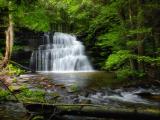
Conservation Overview
Pennsylvania, which means “Penn’s Woods,” is aptly named. While much else has changed since William Penn founded it more than 400 years ago, today's Commonwealth is still 60-percent forested. Two major events—one geologic and one climatic—have shaped the forests and ecosystems found in Pennsylvania today.
Rare Species and Characteristic Habitats
About 300 million years ago, two super-continents collided, and the edges of each crinkled like a French fry. Those wrinkles are still visible today in Pennsylvania as a series of mountainous ridges separated by broad valleys. Along the tops of the ridges, rocky talus slopes and ecosystems called barrens support rare species, such as the Allegheny woodrat and the timber rattlesnake. Where the ridges meet the valley floor, you’ll find ephemeral wetlands called vernal pools, which are home to the northeastern bulrush and a fascinating group of animals called mole salamanders.
More recently—a mere 100,000 years ago—a moving sea of ice more than two miles thick descended on the northeastern and northwestern parts of the state. When the glaciers retreated they left behind depressions and holes, and scattered much of the rock and debris they were carrying. Today innumerable wetlands, bogs, and fens dot these ares of the state, hosting an amazing diversity of highly adapted and often rare plants and animals. The water draining from these wetlands flows into streams that are home to a tremendous diversity of one of North America’s most imperiled fauna, the freshwater mussels.
Public and Private Conservation Efforts
Protecting these natural resources are three state agencies. The Pennsylvania Game Commission works to conserve the state’s birds and mammals and also manages 1.4 million acres of state gamelands. Fish, reptiles, amphibians and aquatic invertebrates fall under the jurisdiction of the Pennsylvania Fish and Boat Commission. And the Department of Conservation and Natural Resources is responsible for conserving the state’s native wild plants and terrestrial invertebrates, as well as managing 2.1 million acres of state forests and 120 state parks. These agencies work closely with many of Pennsylvania’s environmental organizations, like the Pennsylvania Land Trust Association, The Nature Conservancy, Pennsylvania, and Pennsylvania's dedicated land trust organizations.
Threats
Pennsylvania’s special places are facing several significant challenges. As urban areas spread, they chew up valuable and irreplaceable habitat. Even though the state’s population isn’t growing, thousands of acres are lost each year to urban sprawl. The state’s waterways also suffer from the side effects of one of its oldest industries, coal mining. Ten percent of Pennsylvania’s stream miles are significantly impaired due to acid mine drainage. And then there are the as-yet-unknown consequences of climate change; if predictions hold true, the state is likely to see significant changes in both forest composition and the abundance and distribution of many of its native species.





